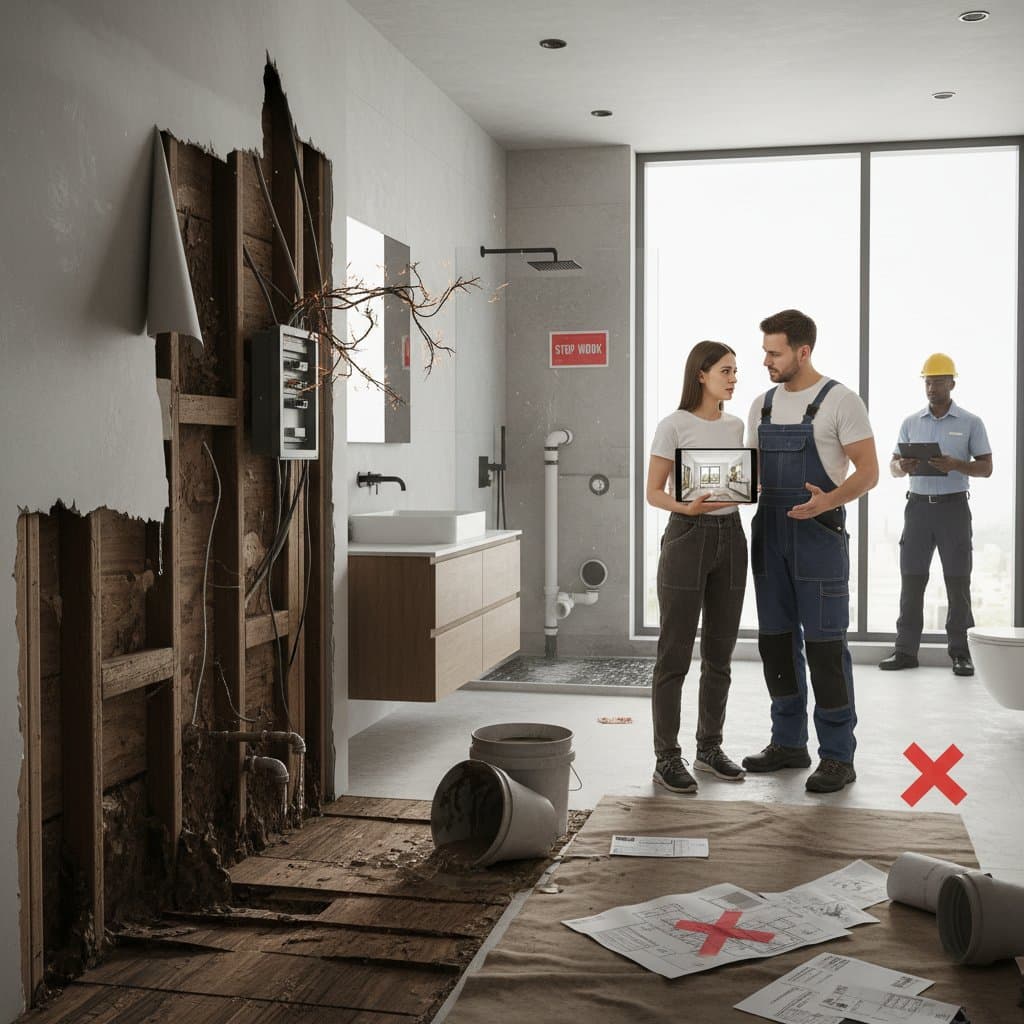DIY Bathroom Remodel Risks: Essential Insights for Homeowners
Homeowners often envision a transformed bathroom after a DIY remodel: sleek tiles, modern fixtures, and a fresh, spacious feel. This vision motivates many to start the project themselves. However, elements like water lines, electrical systems, and structural components introduce complexities that demand careful consideration.
Bathroom remodeling ranks among the most satisfying home upgrades, yet it carries significant risks without proper preparation and expertise. Water, electricity, load-bearing structures, and air circulation intersect in a compact space. Each must operate flawlessly to avoid escalating damage. Before embarking on a solo renovation, grasp the unique challenges that bathrooms present.
Unseen Issues Revealed During Demolition
DIY enthusiasts frequently initiate projects by removing outdated tiles or vanities, only to uncover concealed problems. Water damage, mold, or faulty plumbing can escalate a simple update into extensive repairs. These issues remain hidden until surfaces come down, requiring specialized skills to resolve effectively.
A minor leak behind a shower wall might compromise studs or subflooring. Installing new tiles over such damage leads to cracks and failures over time. Mold demands thorough removal, not just concealment, as humidity fosters rapid regrowth. Professional mold treatment costs $500 to $1,500, while subfloor fixes add $1,000 or more based on extent. Ignoring these discoveries invites steeper future costs.
Plumbing Precision to Prevent Costly Leaks
Bathroom plumbing appears simple at first glance, with sinks, toilets, and showers linking to supply and drain lines. Proper setup requires exact measurements and secure connections. A slight drain misalignment causes gradual leaks that damage floors and walls undetected.
Amateurs often overlook the impact of torque, alignment, and seals on fittings. Excessive tightening cracks pipes; insufficient pressure allows drips. While PEX piping simplifies joins, it still needs knowledge of water pressure and adherence to codes.
Repairing water damage from one leak ranges from $3,000 to $7,000, affecting drywall, flooring, and insulation. Insurers may reject claims tied to non-professional work. Seasoned DIYers thus handle visible elements and delegate wall-embedded plumbing to experts.
Navigating Electrical and Ventilation Requirements
Updating lights or outlets seems straightforward, but bathrooms enforce rigorous electrical codes. GFCI outlets protect areas near water. Faulty grounding or wiring paths pose shock risks. Selecting incorrect breakers endangers the entire system.
Ventilation prevents moisture buildup, which causes mold, paint failure, and drywall deterioration. Choose a fan suited to room volume. Older setups may need exterior ducting, involving ceiling adjustments or new wiring. Combined electrical and ventilation work costs $800 to $2,500, yet it minimizes ongoing issues.
Mastering Tile Installation and Waterproofing
Tiles shape a bathroom's aesthetic, but errors here show prominently. Uneven bases, improper grout spacing, or weak seals permit water infiltration. Moisture then promotes mold and decay behind surfaces.
Experts hone skills in layout, leveling, and barriers over years. Apply cement backer board or liquid membranes behind tiles. Common oversights include neglecting corners or niches, resulting in leaks soon after completion.
Budget $1,500 for tiles and waterproofing materials in a standard bathroom; professional labor starts at $3,000. Self-installation cuts expenses but requires meticulous care. Haste or inadequate prep leads to fixes that negate savings.
Securing Permits and Complying with Codes
Even modest bathroom updates typically need permits. Alterations to plumbing, electricity, vents, or structures must align with local regulations. Unpermitted work risks fines or resale hurdles. Inspectors could mandate exposing completed areas for checks, adding expense and frustration.
Permit fees span $100 to $500 by project scale. The process extends timelines but guarantees safety. Homeowners may perform approved tasks, scheduling inspections as needed. Compliance shields against liability from failures.
Managing Budgets and Timelines Effectively
DIY efforts begin with enthusiasm but frequently exceed estimates. Surprise repairs double material outlays. Tools like tile cutters or pipe crimpers incur extra costs; delays inflate rentals. Expect $5,000 to $10,000 in materials for a typical DIY bathroom, compared to $12,000 to $20,000 professionally. Errors close this difference quickly.
Simple tasks, such as tile cutting or vanity alignment, stretch across days. Incomplete spaces disrupt daily life for extended periods. Plan realistically by dividing into phases: demolition, plumbing, tiling, finishing. This approach sustains momentum and avoids hasty choices.
Determining When Professionals Add Value
Choose DIY or pros based on abilities, schedule, and comfort with risks. Delegate plumbing shifts, electrical enhancements, or structural work to licensed specialists. A combined strategy succeeds: tackle demolition, painting, and assembly personally, while experts manage core installations.
Contractors provide guarantees, code adherence, and streamlined execution to preserve value. They secure supplier discounts and specialized gear, balancing labor fees. In bids, inquire about warranties, insurance, and past projects. Clear communication fosters trust and results.
Practical Strategies for a Flawless Remodel
- Allocate 15 percent extra in your budget for surprises like repairs or upgrades.
- Photograph plumbing and wiring before enclosing walls to aid future work or inspections.
- Verify shower pan slopes to direct water flow and curb mold.
- Select moisture-resistant options: green board drywall, cement backer boards, mold-inhibiting paints.
- Operate exhaust fans post-shower and confirm ducts exit outside, avoiding attics.
- Don safety equipment, including gloves, goggles, and masks, for tasks with dust or chemicals.
These practices yield a durable, attractive space that endures.
Safeguarding Your Remodel Through Routine Care
After completion, regular upkeep sustains the renovation. Reapply grout sealant yearly to block water entry. Examine caulk at tubs and sinks biannually for gaps. Clear fan vents periodically to preserve circulation. Consistent checks prolong material longevity and prevent minor issues from worsening.
